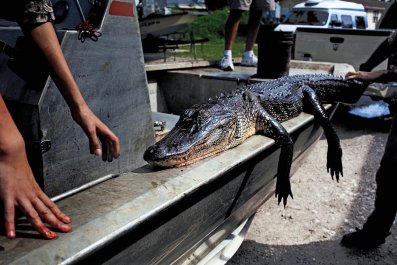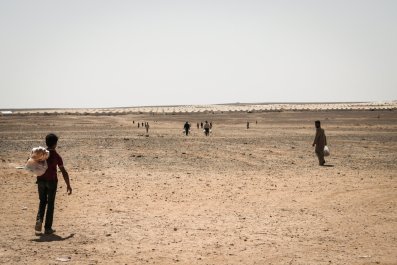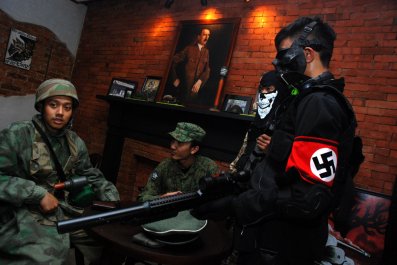Twice in mid-September, Canadian and American fighter jets scrambled as a total of six Russian bombers flew near the North Pole, piercing in the process the jointly administered Canadian and American "air defense identification zone," which rings North America and requires those who enter it to radio their destination. (The Russian aircraft did not do so.)
Russian fighters now routinely buzz the Baltics and have also penetrated the airspace of Finland and Sweden. Earlier this summer, four Russian aircraft flew within 50 miles of the coast of California before veering off. As NATO forces conducted exercises in the Baltics last month, Moscow dispatched 24 warships into waters just off the coast of Lithuania. And in late September, all the way across the vast Russian landmass, Moscow began its biggest military exercises in the Far East in the post–Cold War era.
That Vladimir Putin loved the Cold War is not news. The former KGB officer served in East Germany, one of the key fronts in the 30-year long standoff between Soviet communism and the West, and has since described the demise of the Soviet Union as one of the world's great "tragedies." To some, Moscow's consistent military muscle-flexing is little more than Putin trying to restore a bit of Russia's martial pride after years of pitiful post–Cold War decline.
But coming as these exercises have in the midst of Russia's war in Ukraine, that is not how most war planners and diplomats in the West necessarily see it. At a moment when the United States has been sucked back into an air war in the Middle East, Western diplomats, intelligence agencies and war planners are, more urgently than ever, trying to read Putin's mind.
A September 5 cease-fire between Kiev and Moscow held for a while, but now ever more shakily. Pro-separatists backed by Moscow intensified their attack on Donetsk, a key city in the east. At least 10 children were killed, including at least four on the first day of classes, when a mortar struck a Donetsk playground. Since the start of the "cease-fire," no less than 20 Ukrainian soldiers have been killed. The fragility prompts many to conclude, as one NATO official put it, "that this feels like an interregnum of sorts in this crisis, not in any way like an end point."
Indeed, the conflict between Moscow and the West over Ukraine has continued on other fronts. In response to enhanced sanctions against Russia, legislators in Moscow on September 25 threatened "asset seizures" of foreign companies in the country—a move that analysts say helped contribute to a sharp downturn the same day in the U.S. stock prices.
And Newsweek has learned that should the cease-fire fall apart, NATO is considering providing "defensive" arms to Kiev, despite U.S. President Barack Obama's insistence that there would be no military aid to the country. (The sources declined to say what sort of weaponry NATO might consider providing.)
Against that backdrop, analysts are trying to figure out what Putin may do next. They have, a senior German official says, two major concerns. The first is what the Russians now call "Novorossiya," or New Russia, the contours of which are said to be now a subject of intense discussion in the Kremlin.
It includes major eastern Ukrainian cities, such as Dnipropetrovsk and Kharkiv, still under Kiev's control. It also links Crimea—the portion of Ukraine that Russian separatists seized first—to Transnistria, a province across the Black Sea in Moldova occupied by Moscow. In early September, Russian forces crossed into southeastern Ukraine carrying the flag of New Russia.
The next, more nerve-racking possibility for NATO is a Russian move against one or more of the Baltic states—Estonia, Lithuania and Latvia, NATO members all. All possess significant ethnic Russian populations and thus provide a potential pretext for Moscow, like the one used in eastern Ukraine: Our people's rights were (somehow) being trampled, we had to do something. (Pundits en masse, not unreasonably, have pointed out that this was the same rationale the Germans used in the Sudetenland crisis in 1939.) The recent air incursions into the Baltic states have only intensified concerns that Putin might be crazy enough to poke a NATO member.
On September 3, Obama visited Tallinn, the capital of Estonia, and pledged an increase of NATO forces to the Baltics. He reiterated that the U.S. would live up to its treaty obligations: that an attack on a single NATO member is considered an attack on all and would trigger a military response. "We'll be here for Estonia," Obama said in Tallinn. "We'll be here for Latvia. We'll be here for Lithuania. You lost your independence once before. With NATO, you'll never lose it again."
The bracing question is whether Putin might test that proposition. Might he believe that the new air war against the Islamic State, more commonly known as ISIS, over Iraq and Syria sufficiently distracts Obama and NATO so they won't respond to another Russian "incursion" (the White House's word for what Moscow has done in Ukraine)?
Russian columnist Andrei Piontkovsky wrote recently what some diplomats in Europe now mull privately: "If Putin succeeds and completely subordinates to himself the policy of Ukraine and blocks its [desire to be part of Europe], then he will continue his campaign, and his next target will be the Baltics."
What should be disconcerting to all concerned is that this possibility is mostly dismissed out of hand by most policymakers in Washington and in much of Western Europe. Their refrain is, simply: "Putin's aggressive, yes, but he's not crazy." And though in his Tallinn speech in early September Obama portrayed a West that was united and determined, that rhetorical unity masks what is in fact a deep divide in the West: Simply put, East European diplomats and policymakers very much fear further Putin adventurism beyond Ukraine.
One source pointed Newsweek to a recent column by Anne Applebaum, a foreign affairs columnist for The Washington Post. Under the headline, "War in Europe Is Not a Hysterical Idea," her piece concluded, "Is it hysterical to prepare for total war? Or is it naive not to?" Why would a single column out of hundreds written on the subject be of particular note? Applebaum lives in Warsaw—and her husband is Radek Sikorski, the foreign minister of Poland.
In any event, the U.S. most certainly is not preparing for war—total or otherwise. Is Moscow? And might it come in an unexpected place—say, a move to reinforce its military position in the disputed Kuril Islands in the Far East? In a recent paper, Andrzej Wilk, a senior fellow at the Center for Eastern Studies in Warsaw and a former official in Poland's ministry of national defense, noted Moscow's steadily increasing defense expenditures, and the rapidly increasing tempo of military exercises across the country. "At present," he wrote, "it is increasingly relevant to ask whether the spiral of militarization which Moscow has set in motion has already reached a point of no return." He didn't predict where Moscow might move next, but he warned that it might.
That possibility lay behind the words of Ukrainian President Petro Poroshenko in his recent address before a joint session of the U.S. Congress. "Without any doubt, the international system of checks and balances has been effectively ruined [by Russia's actions]," Poroshenko said. "The world has been plunged into the worst security crisis since the U.S. Cuban Missile [Crisis] in 1962."
It sure doesn't feel like that to the vast majority of Americans, who are currently focusing on the war against the Islamic State. But in central and eastern Europe in particular, the question now concentrating minds is straightforward.
What if Poroshenko is right?
This story has been corrected to reflect the status of the Kuril Islands, which are currently under Russian jurisdiction.

























